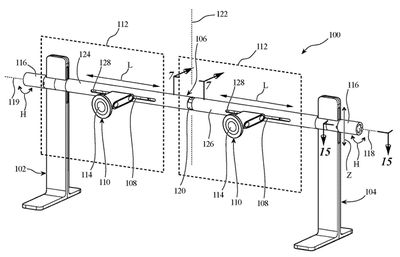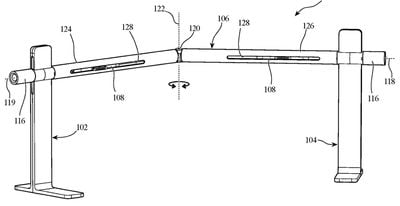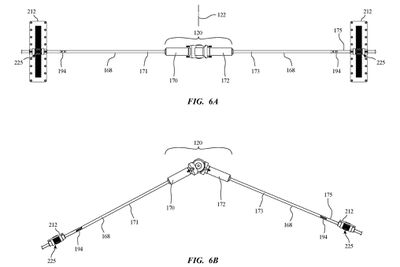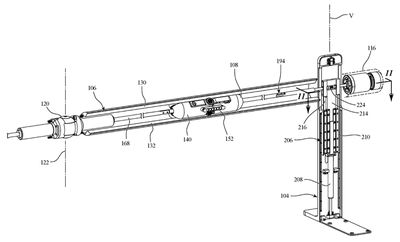A new patent filing reveals a much more versatile multi-display variant of Apple's Pro Stand for the Pro Display XDR. The extremely complex mechanical design seeks to address the shortcomings of existing multi-display solutions, offering easy and precise adjustment for up to two external displays.

The patent, first spotted by Patently Apple, is simply titled "Dual Display Stand," and was first filed with the U.S. Patent and Trademark Office in May 2019.
The filing outlines a large display stand with two spaced-apart legs, connected by a horizontal support bar that allows two displays to be attached. The stand allows for an extraordinary level of precise adjustment and control, with vertical, horizontal, and center pivot degrees of freedom. Apple offers a brief description of the improvements offered by the stand in the patent:
The display stand provides improved smoothness, rigidity, and comfort for the user to support and use multiple displays on a single stand.

The stand seems to use the same moveable joints as the existing Pro Stand, but places them on shuttles and a rail for horizontal adjustment. A central joint on the support bar allows the stand to adjust the angle between the displays.

Both stands have handles to one side that can be turned to easily adjust the height of the support bar for exact vertical adjustment. The patent notes that the entire bar is lifted regardless of the angle of the support bar or which handle is twisted.
The patent also stresses that the shuttles on the continuous rail provide "smooth, consistent contact" with the rails despite adjustments to the support bar using wheels.

The filing explains why the Dual Display Stand solution may be better than existing stand solutions such as independently-movable VESA-mount arms:
When users use multiple displays in a workspace, the displays are generally supported by multiple different individual stands or by independently-movable arms that extend from a single support point. These individual stands or arms unnecessarily take up large spaces, are often aesthetically unpleasing, overcomplicated, and have inefficient redundant mechanisms. When multiple displays are used on independent arms, they can be difficult to align in a smooth and precise way due to inconsistent counterbalancing and arm lengths. When multiple displays are used on a single support, they cannot be effectively adjusted relative to each other about a vertical axis.
It is unusual to see an Apple patent filing that outlines an entire product, particularly one that seems to be so far developed. Normally, patent filings focus on a specific aspect of a product, and while the Dual Display Stand's mechanical operations are all able to come under a single filing, the aesthetic similarities to the existing Pro Stand and general level of completeness is striking.
Given this level of completeness, it is possible that Apple may be planning to bring the Dual Display Stand to retail at some point in the future, or it may be reserved for internal corporate use.
Having said that, patent filings only reliably show what Apple is developing, and many features and products detailed in its patents never see the light of day.
Apple's Pro Stand for the Pro Display XDR, sold separately to the display itself, caused controversy when it was announced in June 2019 for its $999 price tag.





















